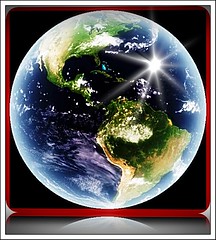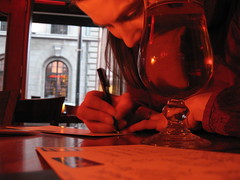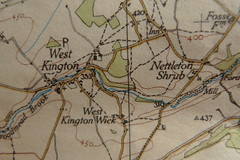Ch.1 AP Human Geography :
The Cultural Landscape: An Introduction to Human Geography
| 441855185 | Geography | The study of the earth's surface, climate, continents, countries, peoples, industries, and products. |  |
| 441855186 | Eratosthenes | The head librarian at Alexandria during the third century B.C.; he was one of the first cartographers. Performed a remarkably accurate computation of the earth's circumference. He is also credited with coining the term "geography." |  |
| 441855187 | Geo | root meaning earth |  |
| 441855188 | graphy | greek root that means "to write". |  |
| 441855189 | Human Geography | One of the two major divisions of geography along with physical geography; the spatial analysis of human population, their cultures, activities, and landscapes. |  |
| 441855190 | Physical Geography | One of the two major divisions of systematic geography; the spatial analysis of the structure, processes, and location of Earth's natural phenomena such as climate, soil, plants, animals, and topography. |  |
| 441855191 | Distribution | The arrangement of a feature in space, is made up of 3 properties : density, concentration, and pattern. |  |
| 441855192 | Density | The frequency with which something exists within a given unit of area(km, miles, acres etc.). One of the 3 properties of distribution along with concentration and pattern. |  |
| 441855193 | Concentration | The extent of a feature's spread over space. Can be either clustered(relative) or dispersed. | |
| 441855194 | Pattern | The geometric arrangement of objects in space. One of the three propertied of distribution. |  |
| 441855195 | Arithmetic Density | The total number of people divided by the total land area. An aspect of density. | |
| 441855196 | Physiological density | The number of people per unit of area of arable land, which is land suitable for agriculture. | |
| 441855197 | Agricultural Density | The ratio of the number of farmers to the total amount of land suitable for agriculture, a high ratio means that there is inefficient agriculture in that region. | |
| 441855198 | Arable land | Land suitable for growing crops, is one of the fectors determining physiological density. |  |
| 441855199 | Housing Density | number of dwelling units per unit of area, a high amount means that there may be overcrowding. |  |
| 441855200 | Map | a two-dimensional, or flat, representation of Earth's surface or a portion of it |  |
| 441855201 | Cartography | science or art of making maps, tis awesome. |  |
| 441855202 | Stick Charts | Earliest form of navigational or oceanographic map made of bamboo and shells, they were made by the Polynesian people among the south pacific islands. Shells represented Islands and palm strips represented patterns of waves between Islands. | |
| 441855203 | Anaximander | Greek philosopher and student of Thales, made an early World map based on information of sailors , however he INCORRECTLY made the map a cylinder. | |
| 441855204 | Thales | Introduced geometry to the Greeks; figured out how to indirectly measure the height of a pyramid, diameter of a circle, right angles in circles. Taught Anaximander. | |
| 441855205 | Hecateus | Greek who created the FIRST Geography book around 500 B.C.E. | |
| 441855206 | Aristotle | First to demonstrate that the world was spherical(circular shadow on the moonduring an elipse, blah blah, blah) |  |
| 441855207 | Ptolemy | Roman geographer-astronomer and author of "Guide to Geography" which included maps containing a grid system of latitude and longitude. Were not improved on for a thousand years. |  |
| 441855208 | Guide to Geography | Ptolemy's 8 volume book that codified the principles of mapmaking. | |
| 441855209 | Fei Xiu | "The father of Chinese Cartography" also known as Phei Hsiu. | |
| 441855210 | Remote Sensing | The acquisition of data about Earth's surface from a satellite orbiting the planet or other long-distance methods. |  |
| 441855211 | GIS | Geographic Information System, A computer system that stores, organizes, analyzes, and displays geographic data(Topography, political boundaries,soil etc). | |
| 441855212 | GPS | Global Positioning System., a navigational system involving satellites and computers that can determine the latitude and longitude of a receiver on Earth by computing the time difference for signals from different satellites to reach the receiver. |  |
| 441855213 | Geradus Mercator | One of the first people to produce a world map that showed withe relative accuracy, the general outline of the continents., printed the first map that arrived the names of both the continents of N. and S. America and made map a that showed asia and N. america were separate continents | |
| 441855214 | Abraham Ortelius | Who published 17 supplementary maps under the title Additamentrum theatri Orbis terrarum(First Atlas). Also , with Sir Frances Bacon both noted that the coastlines of certain continents seemed to fit together when placed near each other on a map |  |
| 441855215 | Projection | method of transferring locations on the Earth to a flat surface distortions that result include shape, distance, direction, and relative size. | |
| 441855216 | Equal Area Projections | A map projections that shows the sizes of regions in correct relation to one another but distorts shapes, | |
| 441855217 | Interruption | A feature of equal area projection that separates the Eastern and Western Hemispheres into two pieces. | |
| 441855218 | Robinson Projection | An Uninterrupted Projection that attempts to balance several possible projection errors. It does not maintain completely accurate area, shape, distance, or direction, but it minimizes errors in each. |  |
| 441855219 | Mercator Projection | An Uninterrupted true conformal cylindrical map projection, this projection is particularly useful for navigation because it maintains accurate direction.Famous for their distortion that makes the landmasses at the poles oversized making high latitude places look much larger than they are. |  |
| 441855220 | Location | The position that something occupies on earth's surface. Can be identified by 4 ways (toponym, site, situation, and mathematical location) |  |
| 441855221 | Toponym | name given to a place on earth, think place name(In this case Mt. Everest). |  |
| 441855222 | Board of Geographical Names | Operated by the US Geological Survey, is the final decider of names on U.S Maps. | |
| 441855223 | U.S. Geological Survey | Established in (1879) A federal agency that studies landscapes and maps the land and its natural resources, looking for any possible natural hazards through the disciplines of biology, hydrology, geography, and geology. This is a non-regulatory agency of the Department of the Interior. Operates the famed "Board of Geographical Names". |  |
| 441855224 | Site | The physical characteristics of a place, Include climate, water sources,topography, soil,elevation, and latitude, one of 4 ways to find location. | |
| 441855225 | Situation | The relative location of a place in relation to the physical and cultural characteristics of the surrounding area and the connections and interdependencies within that system; a place's spatial context. | |
| 441855226 | Meridian | An arc drawn on a map between the North and South poles. | |
| 441855227 | Parellel | any of the imaginary circles around the earth parallel to the equator, marking degrees of latitude | |
| 441855228 | longitude | The numbering system used to indicate the location of meridians drawn on a globe and measuring distance east and west of the prime meridian (0°). | |
| 441855229 | Prime Meridian | The meridian, designated at 0° longitude, which passes through the Royal Observatory at Greenwich, England. |  |
| 441855230 | latitude | The numbering system used to indicate the location of parallels drawn on a globe and measuring distance north and south of the equator. | |
| 441855231 | Time Zones | One of the 24 regions or divisions of the globe approximately coinciding with meridians at successive hours from the observatory at Greenwich, England. |  |
| 441855232 | GMT | Greenwich Mean Time. The time in that time zone encompassing the prime meridian or 0 degree longitude, also known as universal time(UT). | |
| 441855233 | International Date Line | is an imaginary line of longitude generally 180° (degrees) east or west of the Prime Meridian. The International Date Line is where each new day begins. |  |
| 441855234 | Equator | an imaginary circle around the middle of the earth, halfway between the North Pole and the South Pole, largest circumference. |  |
| 441855235 | Longitude Act of 1714 | Act of Parliament of the United Kingdom passed in July 1714 during the reign of Queen Anne. It established the Board of Longitude and offered a monetary reward (Longitude Prize) for anyone who could find a simple and practical method for the precise determination of a ship's longitude. Won by John Harrison. | |
| 441855236 | John Harrison | Worked with clocks and compasses for longitude and lattitude and created the "Marine Chronometer" which estimated one's exact longitude at sea. |  |
| 441855237 | Region | an area of Earth distinguished by a distinctive combination of cultural and physical features. Like "the South". |  |
| 441855238 | Regional Studies | An approach to geography that emphasizes the relationships among social and physical phemona in a particular area study (cultural landscape) | |
| 441855239 | Formal Region | (or uniform or homogeneous region) an area in which everyone shares in one or more distinctive characteristics(like language ,religion, climate etc.) Examples are States like Montana, corn belt. One of 3 types of regions. | |
| 441855240 | Functional Region | Also called a (nodal region) Area organized around a node or focal point. The characteristic chosen to define a functional region dominates at a central focus or node and diminishes in importance outward. This region is tied to the central point by transportation or communication systems or by economic or functional associations., Example could be circulation of newspapers. | |
| 441855241 | Vernacular Region | Can also be called a (Perceptual Region) is a place that people believe exists as a part of their cultural identity. Such regions emerge from peoples informal sense of place rather than from scientific models developed through geographic thought. (Often identified using a mental map- which is an internal representation of a portion of Earths surface), Like "the South" | |
| 441855242 | Culture | The body of customary beliefs, social forms, and material traits that together constitute a group of people's distinct tradition |  |
| 441855243 | Popular Culture | Culture found in a large, heterogeneous society that shares certain habits despite differences in other personal characteristics |  |
| 441855244 | Religion | an organized system of ideas about the spiritual sphere or the supernatural, along with associated ceremonial practices by which people try to interpret and/or influence aspects of the universe otherwise beyond their control |  |
| 441855245 | MDC | More Developed Countries, Countries with higher levels of per capita income, industrialization and modernization. they usually have lower levels of population growth. The developed region includes all of Europe, Canada, the U.S., Australia, Japan, New Zealand and the USSR | |
| 441855246 | LDC | Less Developed Countries, A country that has low levels of average wealth, industrialization and modernization and often high levels of population growth and people employed in agriculture | |
| 441855247 | Cultural Ecology | The geographic study of human - environmental relationships | |
| 441855248 | environmental determinism | A nineteenth- and early twentieth-century approach to the study of geography that argued that the general laws sought by human geographers could be found in the physical sciences. Geography was therefore the study of how the physical environment caused human activities. | |
| 441855249 | Carl Ritter | German geographer. Occupied the first chair in Geography at the University of Berlin until his death in 1859. Along with Humboldt, considered a founder of modern geography. Wrote 'The Science of the Earth in Relation to the Nature and the History of Mankind'. Emphasized environmental determinism. | |
| 441855250 | Alexander von Humboldt | He is considered one of the founders of modern geography work on botanical geography was foundational to the field of biogeography; set about the task of collecting and analyzing data about the relationships between the spatial distribution of rocks, plants, and animals. |  |
| 441855251 | Possibilism | The modern geographic theory which rejects environmental determinism of Ritter and Humboldt, and states that the physical environment may set limits on human actions, but people have the ability to adjust to the physical environment and choose a course of action from many alternatives. | |
| 441855252 | Resources | all the things used in producing goods and services | |
| 441855253 | Polder | Land created by the Dutch by draining water from an area. Make up around 16% of the total land area of the Netherlands. |  |
| 441855254 | Dikes | Netherland builds these to keep the water from getting on the land made of soil. |  |
| 441855255 | Zuider Zee | This is a section of the North Sea that once threatened the Netherlands with flooding. A dike completed in 1932 caused this to be converted from a saltwater sea to a freshwater lake. Some of the lake has been drained to create several polders, encompassing an area 1,600 square kilometers. |  |
| 441855256 | Delta Plan | A System of dams/dikes were built to seal off/protect Netherland's SW coast | |
| 441855257 | Scale | Generally, the relationship between the portion of Earth being studied and Earth as a whole, specifically the relationship between the size of an object on a map and the size of the actual feature on Earth's surface. | |
| 441855258 | Globalization | The trend toward increased cultural and economic connectedness between people, businesses, and organizations throughout the world. |  |
| 441855259 | Transnational Corporation | A company that conducts research, operates factories, and sells products in many countries, not just where its headquarters or shareholders are located. |  |
| 441855260 | Space-time compression | The reduction in the time it takes to diffuse something to a distant place, as a result of improved communications and transportation systems. | |
| 441855261 | Distance Decay | The diminishing in importance and eventual disappearance of a phenomenon with increasing distance from its origin. Typically, the farther away one group is from another, the less likely the two groups are to interact. (Electronic devices such as the internet and e-mail have aided in eliminating barriers to interaction between people who are far from each other. | |
| 441855262 | Color line | a barrier supported by customs and laws separating nonwhites from whites, especially with regard to their roles in the division of labor; it can be traced to the European colonization of Africa. | |
| 441855263 | Diffusion | The spatial spreading or dissemination of a culture element or some other phenomenon over time. Originates in the "Hearth", Two main types: Relocation and expansion. | |
| 441855264 | Hearth | the region from which innovative ideas originate, emerges because a community invests and allocates resources to nurture the innovation. 3 major of these are North America, Western Europe, and Japan). | |
| 441855265 | Relocation diffusion | The spread of an idea through physical movement of people from one place to another. Such as through migration. Can explain AID'S distribution. | |
| 441855266 | Expansion diffusion | The spread of an innovation or an idea through a population in an area in such a way that the number of those influenced grows continuously larger(snowball effect), resulting in an expanding area of dissemination. Results in one of 3 ways: Hierarchical diffusion, contagious diffusion, and stimulus diffusion. | |
| 441855267 | AZT | An antiviral drug (trade name Retrovir) used in the treatment of AIDS, helps explain the rapid decline of AID'S cases in the 1990;s is an example of expansion diffusion. | |
| 441855268 | Snowball effect | The tendency for people to share informal information with others with whom they come into contact, helps contribute to expansion diffusion. | |
| 441855269 | Hierarchical diffusion | The spread of an idea from persons or nodes of authority or power to other persons or places, one of 3 aspects of expansion diffusion along with stimulus diffusion and contagious diffusion. | |
| 441855270 | Stimulus diffusion | The spread of an underlying principle, even though a specific characteristic is rejected. | |
| 441855271 | Contagious diffusion | The rapid, widespread diffusion of a feature or trend throughout a population. Facillitated by the World Wide Web and other high technologies. (Medicinal, advice etc) | |
| 441855272 | Uneven Development | The increasing gap in economic conditions between core(3 hearths) and peripheral regions as a result of the globalization of the economy. |

